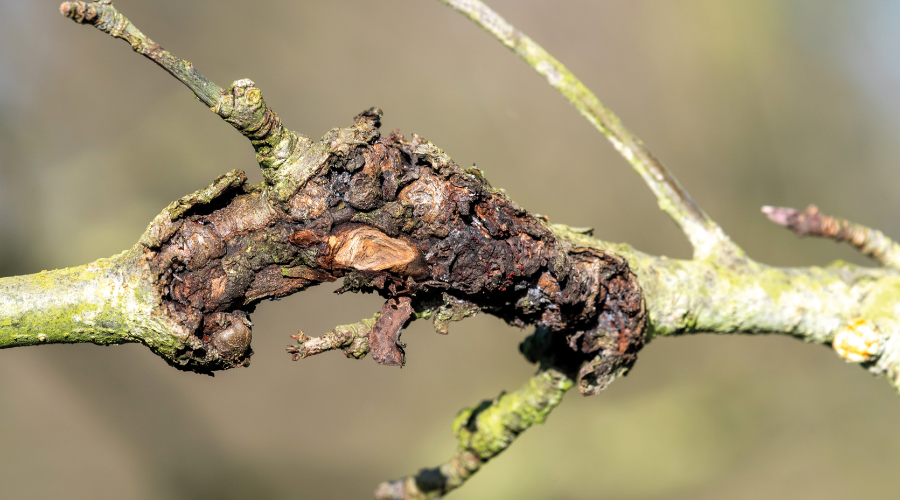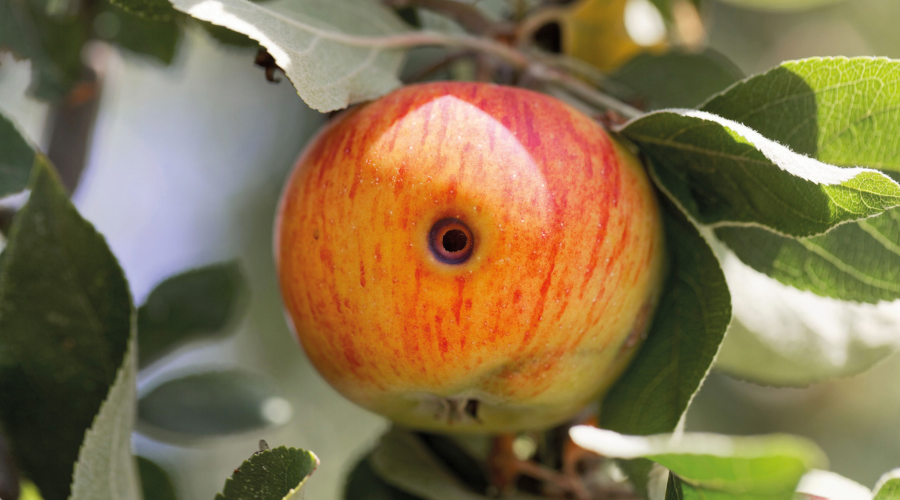Latest findings in apple pest and disease research
15th April 2025
The impact of climate change and loss of chemical controls for top fruit pests and diseases were key themes at this year’s BAPL/NIAB R&D meeting. Sarah Kidby reports.

Apple canker
NIAB’s Matevz Papp-Rupar shared grower data which revealed a tendency for low/medium canker scores where potassium levels were below 124.7mg/L, and high scores above this threshold.
Surprisingly, NIAB data found more canker in orchards with increased calcium in the soil, and an association between high canker and increased soil phosphorus, copper and cobalt. Increased SO4 and zinc in soil, however, were associated with very low canker – but more research is needed.
Meanwhile, Louisa Robinson-Boyer found tree mortality was consistently reduced across six newly planted commercial orchards where arbuscular mycorrhizal fungi (AMF) and tricoderma treatments were applied.
When AMF and Vintec (Trichoderma atroviride) and AMF and Trianum (Trichoderma harzianum) were applied together, mortality fell by 50% compared to the control.
All six sites also saw a reduction in mainstem canker by adding AMF, but not peripheral canker.
Unsurprisingly, girth reduced in the first year as a result of adding mycorrhiza, but trees recovered completely in the second year. For existing orchards, wildflowers planted in alleyways can increase AMF; and AMF tends to restore negative effects of root pruning or wildflower planting, the study suggests.
Biochar
With burning trees at the end of orchard life being increasingly undesirable, speakers discussed whether biochar could offer a solution, as well as generating carbon credits for farmers, and products including heat, which would be used directly or in a CHP unit to generate electricity.
It’s hoped biochar could also improve the establishment of young trees and overcome apple replant disorder, said Hutchinsons agronomist Rob Saunders.
Codling moth
A project at three commercial sites in Kent found biological approaches were just as effective as conventional insecticides (indoxacarb and chlorantranilliprole) when it comes to tackling codling moth, shared Jonathan Blackman, Hutchinsons.
The cost of biological treatments was higher, but as they took a cautious approach, applications could have been reduced.
Woodlice
A project at a commercial orchard found woodlice damage was worse later in the season, said Rory Jones, ADAS, suggesting growers could consider prioritising picking the more at-risk sections of the orchard.
It’s not known when woodlice are entering the trees but the study indicated they are present as early as the end of August. Laboratory testing showed promise for phagostimulant baits, but an appropriate killing agent is needed.
Nigel Jenner, Avalon Fresh, advised growers to consider running stores in air for 3–4 days before sealing, as research found woodlice die within 3–4 days without moisture.
Feeding ceases under 10ºC so this should be established as soon as possible. Finally, for varieties that will tolerate it, running high CO2 (above 1ºC) will kill woodlice and reduce apple damage dramatically.
Forest bug
Forest bug control must now be carefully considered to avoid harming beneficials.
Paul Hamlyn, ACH Farming, and Alex Radu of Agrovista both stressed the importance of monitoring year-round using beating trays, especially in warm conditions.
The best time is October–April to get a good idea of what you have in the orchard.
Flipper is a bioinsecticide with a low impact on beneficials. Spruzit and Tracer – both broad spectrum, though the former has no or very short persistency – offer good efficacy, Alex said.
Decis and Hallmark are very broad spectrum and persistent in the environment, however. Decis is not taken up by foliage, but Hallmark is by far the most persistent and harmful to beneficials.
Rosy apple aphid

Charlotte Howard, from the University of Reading, found planting wildflower margins (four low growing fine grasses and 15 perennial wildflowers) at 10 orchards reduced the number of aphids on infested trees and the number of trees with fruit damage from 80% to 50%.
The benefits reached up to 50m from the flower margins – as far as the team measured.
Apple storage
Richard Colgan, University of Greenwich, outlined a project looking at low oxygen apple storage.
Traditionally growers store at ‘five and one’ – 5% CO2, 1% O2, though some prefer 3% CO2 and 1% O2.
There has been an advent of dynamic controlled atmosphere storage, allowing oxygen concentrations to be reduced to 0.6–0.4%, which could help to reduce the internal breakdown of fruit, and scald.
Products such as SafePod are available for strict monitoring of fruit stress.
The study explored using:
·1% CO2, 3% O2
·3% CO2, 0.4% O2
·<1.3% CO2, 0.4% O2.
Fruit was kept in store for 8–9 months, with very little impact on firmness, shelf life, quality and Brix.
However, the ‘three and one’ system had the most rots by eight months, and the 3% CO2, 0.4% O2 had the least. Lower oxygen also helped to reduce internal breakdown.
Read more fruit news.
